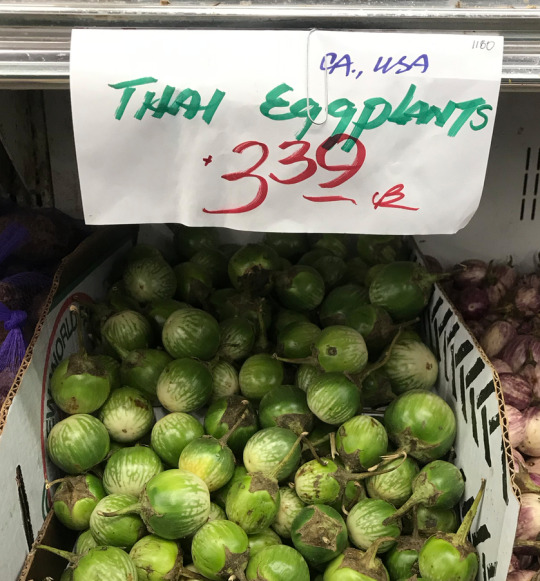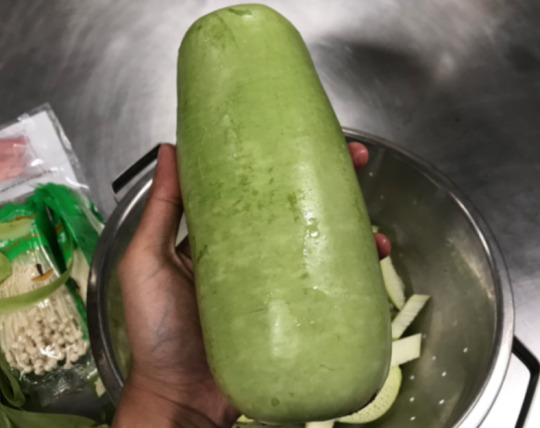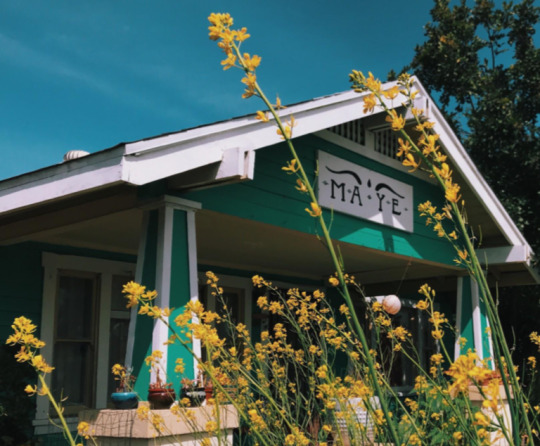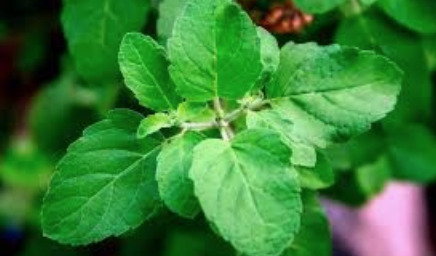This blog is meant to document my food and farming journey. It is initially made as an assignment for a class, but possibly more?
Don't wanna be here? Send us removal request.
Text
Entry #6: Market Comparison
I decided to compare Safeway and Berkeley Bowl. Before going to these two places, I made a checklist of food ingredients that are typical in Khmer cuisine to look out for. They are:
holy basil, fish cheek mint, fermented fish, saw tooth mint, lemongrass, bittermelon, green eggplants, gourds, tamarinds
⟹ First stop: Berkeley Bowl
To my surprise, Berkeley has more ingredients than I had expected! Even though I couldn’t find holy basil, fermented fish and saw tooth mint, I found the rest!
Here are some pictures I took:


(Extra: elephant Ear)





(extra: even durians!)
⟹ Second stop: Safeway
Out of the ingredients I chose to keep track off, lemongrass is the thing I found in Safeway : (. The price difference is noticeable too.

Conclusion: It is not definitely surprising for me to declare Berkeley Bowl as the clear winner of this comparison. In Berkeley Bowl, I felt the authentic Asian produce section vibe that I have experienced at other Asian markets. It was not just the hand-written signs or the old counters, it was also the huge varieties of fruits, vegetables, and herbs that very much caught my attention. Everything was not washed clean like in Safeway. I think that is better because I felt that these vegetables were coming from different and more local places that mandated less sparkly vegetable machinery like those to wash the kind of overpriced lemongrass in Safeway. I think it is definitely still good for Safeway to include an Asian produce side, but I feel the option is way too limited and overprice. One might say there is still an option in Safeway, but in the long run, availability doesn’t really justify affordability.
0 notes
Text
Entry #5: Food Culture Interview 1/A
A is a Khmer Cal graduate who is currently living in San Fernando Valley. She moved to the U.S. about ten years ago. In addition, she is an avid cook and has a lot of experience in making Khmer cuisine. I wanted to interview Amy because I really wanted to know her thoughts on the differences between growing up in America and back in Cambodia. [interview conducted through phone]
Q: Let’s start. Can you describe the Cambodia cuisine?
A: Cambodian food is unique. We tend to use a lot of kreung. . . ingredients like lemongrass, galangal, turmeric, etc.
Q: what makes Khmer cuisine unique from Thai or other Southeast Asian cuisine?
A: Thai food tends to use more coconut. For us, we used a lot of kreung– lemongrass most of the time. . . Even in curry, we even use kreung. We also use fermented stuff, which is saltier. Thai people tend to use shrimp paste. [Fermented stuff] is an integral part of our cuisine. I don’t know the right source. . . [but] fermentation is the stable way of extending life when there is no access to refrigeration.
Q: Do you think the Khmer rouge has any impact on the Cambodian cuisine?
A: I remember that uncle told us that he was in the regime for a while. He love barbar (porridge) and he is eating more than in the Pol Pot era. One thing that my parents would teach me is frugality. . .making sure that I finish my food. They told me to think about the people harvesting the rice . . . sometimes superstition– that leaving grains of rice would make you get pimples.
Q: Do people in your family talk about the regime at all?
A: I heard that my grandaunt lost all of her [immediate] family members due to starvation. My granduncle, after the regime, was very hungry. He was overeating too much and his body couldn’t take it.
Q: Do you think the food over here is different than that in Cambodia?
A: The flavors are definitely different. The ingredients are fresher. In terms of the aroma, it is tastier. . . it is mostly the freshness of the ingredients.
Q: You were born in Cambodia, where you were exposed to your native cuisine and ingredients everyday, how is growing up in the US?
A: Well at the beginning, our ingredients were inaccessible because we didn’t know the way around in the U.S. Here, there is not a lot of supermarkets. We would return [ from Cambodia] with dried rice paddy herbs and tamarind without the seeds.
Q: Can you use substitution and stuff?
A: We substitute a lot of our ingredients like in somlar machu youn. . . we use celery in machu kreung . . . to replace vegetables like green papaya. For Kdat or elephant ear, in the beginning, we didn’t put into the somlor because couldn’t find them.
Q: Where do you live? What is your usual place to get ingredients?
A: San Fernando Valley. My family usually goes to Asian supermarkets or Hispanic markets–they sell tamarind, cilantro, green onion, jicama! I was surprised to see tamarind, so we didn’t actually have to bring tamarind back from Cambodia anymore.
Q: Do you or your parents cook Cambodian food every day?
A: Cambodian food every day. We sometimes go out to get fast food like Costco pizza, in-n-out, or Cambodian, Vietnamese restaurants etc.
Q: Do you prefer the Cambodian cuisine, though?
A: I try to cook or just try Cambodian restaurants. My dad is very picky, so we try to make our own food. We try growing mint, lemongrass, green onion, Thai basil. . . started to grow rice paddy herbs but died
Q: When you were in college, was it hard to acquire Cambodian food? Was there a lot of Cambodian restaurants nearby?
A: I go to Safeway where I found gourd, lemongrass, thai basil. For machu youn, I just use Thai basil to substitute the rice paddy herb. . . no, not a lot of Cambodian markets nearby. There is a Vietnamese market called Thien Loi Hoa that I went to sometimes.
Q: Where do you go to get Southeast Asian food?
A: Pho places, banh mi in Saigon Express. If I crave Cambodian food, I’d just go to Thai restaurants like Racha. The cuisine is more similar to Cambodian cuisine. . .I don’t really get satisfied because it’s not the same. . .flavor is different, so most of the time, I prefer to make own food instead.
Q: Now you are back in SFV, do you still make your own food?
A: Now. . . I’m usually busy. My mom makes them most of the time. I sometimes cook. . .like it over here more because of the food, also don’t have to cook much. If I were to really, really need ingredients for something, my parents and I drive to Long Beach.
Q: How long does it take to get there?
A: about 45 minutes - 1:00 hour.
Q: Do you prefer to live in SFV or in long beach?
A: SFV. I don’t really mind the drive. If it takes more than 2 hours just to get the ingredients, I would just not go to Long Beach.
Q: In the future, do you think Cambodian food will be a big part of your life?
A: Yeah. . .I didn’t realized how much I missed Cambodian food when moving to college. When I visit Cambodia, I eat a lot of food!
Q: Do you think teaching your kids cuisine is important?
A: I see it as a way to preserve culture. Food is an important aspect of culture that can be passed on from generation!
0 notes
Text
Entry #4: Dish reflection - Somlar Machu Youn
Everything turned out better than I thought!
Here are some of the pictures I took along the process of making the dish!
1. admiring the green gourd that I got from Berkeley Bowl (I didn’t take a photo of the elephant ear, but the pieces should be green sticks in the bowl!)

2. cutting the gourd into little chunks

3. gathered all of the veggies

I didn’t take photos of the rest of the process, but I really enjoyed making and tasting the dish. I was not very stressed this time since I tried to make the dish–two years ago. . .However, everything was still not as planned, and I had to improvise.
For example, I decided to include shrimps since I couldn’t find a lot of fish in my coop’s freezer. If I were to include shrimps again, I would choose jumbo shrimps since the ones I used turned out to be way smaller when cooked. In addition, I decided to use thai basil since I couldn’t find rice paddy herb (Limnophila aromatica) in Berkeley Bowl.
Another thing: I used more fish sauce and tamarind paste more than expected! It is hard to describe the taste without “tasting” it, but the finished product should be an equal combination of umami, sour, and sweet.
I actually ended up making more than enough for myself and decided to share them with my coop-mates. There were mixed reactions. Among the five people I shared the dish with, four liked the dish. So, that’s like 80% of good reactions? Good enough, I think. One person didn’t like the dish because he thought that it was very weird to put pineapple in a soup– and started to question why people put pineapple, a fruit, on pizza. Another person and I started to question him: “why do people use tomatoes in pizzas? Aren’t tomatoes fruits?” It’s kind of strange, but I started to think about the reading from Tomatoland– learning that tomato originated from the Americas. Somehow, Europeans started to include it in their pizza– and now, it is normal? It wasn’t normal to some Europeans back then. Some people even thought that tomatoes were pretty much poisonous. I guess more time or exposure means people would be more like to accept other people’s food culture? I hope this blog would help to increase exposure then!
Here is the finished product : )

0 notes
Text
Entry #3: Food Culture Reflection
Now that you all are somewhat familiar with Khmer cuisine, I think it’s time for me to reflect on where I came from, and where I am today in terms of food culture.
I spent my first ten years in Cambodia, and the food culture there was very different than that in California. In Cambodia, there was little to no refrigeration. People often resort to ferment or pickle food to extend their shelf lives. If one wants refrigeration, then buying ice from the markets would be the way to go. Like many other families, my family often had to go to the market every day, usually around 11 or 12 PM, since we didn’t use ice. In the markets, we could find main ingredients like fish, beef, chicken, and other ingredients that we didn’t have or know how to make like fermented fish, etc. Other ingredients included fresh fish cheek mint, peppers, gourds, tamarind, holy basil, lemongrass, lime, mango, banana stem and flowers, green eggplants, (sdao) bitter leaves, moringa, and many more tropical produce. In addition, it was common to find insects like crickets in our cuisine. I remember that during the rainy season, my family and neighbours would put out purple lights to attract insects. Long plastic sheets, with water at the bottom, were extended from the light. At the bottom, the insects’ wings would get wet, and they wouldn’t be able to fly away. I heard that things used to be different before the Khmer Rouge Regime, but the Khmer food culture was forever changed after the regime. During the regime, since people were not allowed sufficient food, many resorted to steal vegetables and eat things that they wouldn’t eat– like bugs, tree barks, etc. in order to survive. Currently, cooked insects are somewhat normalized in many regions in Cambodia.

(photo of my uncle’s backyard in Cambodia)
In the U.S., my family decide to stay in Long Beach, CA, where there are a lot of Cambodian people and markets. The markets aren’t necessarily all Cambodians, but Khmer people often shop in some Vietnamese or Thai markets, since our cuisines are very similar. In Khmer markets, like in Kun Heng, people have more access to vegetables and ingredients like gourds, bitter melons, thai basil, rice paddy herbs, banana leaves, etc. Ready-made food often includes Khmer sour-soups and desserts. Here, differences are mainly noticeable in the lack of backyard farming. Based on my observation, most Cambodian people are immigrants and from low-income backgrounds. Thus, most often can’t afford big houses with accessible backyards to actually grow their culturally appropriate foods. There are some community gardens in Cambodian town like the MAYE Center and Gladys Ave Garden, but people, like my parents and their friends, have to work long hours and are not able to become involved in these community gardens.

(photo of Maye Center in Long Beach)
Living in Berkeley has been a totally different experience for me than living in Long Beach. There are way less Cambodian people here. The nearest Cambodian towns are in Oakland and Stockton, but they’re somewhat inaccessible to me since I don’t drive a car. During freshman and sophomore year, I often used Line 1 to go to Cambodian markets on International Blvd in Oakland. However, since Line 1 has been remapped, I haven’t been to these markets since then. In terms of restaurants, there are no Cambodian restaurants in Berkeley. If I wanted to have something Cambodian to eat, I often go to Thai Noodle, Thai Basil, or Saigon Express. However, I feel these foods don’t really hit close to home. For markets, I find it hard to find ingredients that I would need to cook Khmer food. I usually go to Safeway, but I feel Berkeley Bowl carries a better selection in terms of Southeast Asian vegetables and ingredients. I’m pretty much a novice in terms of cooking. Cooking food has been very daunting. However, I feel that food is such an integral part of my identity that I should definitely learn or just experiment more by making them. There have been occasions when I really wanted to try to cook something like Somlor Machu Youn. After looking at the ingredients listed on Youtube videos and blogs, I would soon become disheartened, thinking that I would never find lotus shoots, tamarind powder, rice paddy herb, fermented fish, etc. in Berkeley Bowl.
Nevertheless, I hope that creating this blog would help to make Khmer recipes more accessible to me and people who really wanted to try making Khmer food. However, I think it is pretty important to recognize that I have little experience cooking Cambodian food. At this moment, I will be very satisfied if by creating this blog, I feel more ready to tackle making some sour-soups, even if I don’t have all of the ingredients to begin with.
0 notes
Text
Entry#2: Recipes
Disclaimer: The following recipes are from my own cooking experiences. I am definitely a novice when it comes to cooking, but I find it very worthwhile to at least try to make Khmer Cuisine– especially while I am still in college. In other words, there might be some mistakes, but I definitely hope this post would help people to be more familiar with Khmer cuisine. By all means, the recipes in this post don’t represent the overall Khmer dishes, but they are frequently made in my home.
How would I classify Khmer Cuisine? Well, almost every dish needs to be eaten with rice. A typical Khmer dish is usually made with a lot of flavors– whether sweet, salty, spicy. So, rice definitely helps to neutralize the strong flavors.
1. Cha Peng-Poh (Tomato Stir-Fry)
Ingredients:
Tomatoes: 4 fruits
Garlic: 2 cloves
Brown sugar: to taste
Salt: to taste
Eggs: 2 (optional)
Optional: oyster or hoisin sauce
Tofu or meat (chicken or beef): variable
Directions:
Mince the garlic.
Cut tomatoes, tofu/meat into desirable size. (Tomatoes cut into quarters or eighths)
Heat oil in the pan and then add minced garlic.
Add tofu or meat. Stir until tofu/meat is well done.
Add tomatoes. Continue stirring until seeds become loose and tomatoes become soft.
Add salt, sugar (and oyster/hoisin sauce)
Put black peppers.
Serve with white rice.
2. Sa-gnow Mareah (Bitter Lemon Soup)
Ingredients:
Bitter melons: 3 bitter melons
Garlic: 3 cloves
Ground pork: ½ pound or variable (could use finely chopped tofu to substitute)
Sugar: to taste
Salt: to taste
Soup base: vegetable or chicken bouillon- ½ cube
Black pepper: variable
Green onion: variable
Vermicelli noodles: variable
Dried or fresh shrimp: optional
Directions:
Cut bitter melons into halves or thirds if big. Take the seeds out with spoons.
Mince garlic. Chop green onions into 4-5 mm. Chop tofu into little pieces.
(optional): submerge dry shrimp into the water until soft.
Heat the Vermicelli noodles. Then cut into little pieces.
Mix meat/tofu, garlic, vermicelli, shrimp together with black pepper in a bowl.
Stuff ingredients from the previous step into the bitter melon.
Heat water and add soup base.
Add stuffed bitter melons into the soup. Wait until bitter melons become soft.
Serve with rice. (optional: use lime and soy sauce for condiment)
3. Somlar Machu Youn (Vietnamese sour soup) –> will include pictures in another post : )
Ingredients:
Water lily shoots: 5-10 shoots, variable
Tomatoes: 4 fruits
Tamarind (fruit/paste/powder): 3-4 fruits or to taste
Rice paddy herbs: 3 stems
Pineapple tidbits: ½ - 1 can
Elephant ear: 1 stem
Fish sauce or liquid amino: to taste
Green gourd: 1 fruit
Lemongrass: 2 stem
Fish or chicken: variable
Mushrooms: variable
Soup base (vegetable or chicken): ½ of a cube
Shrimps: optional
Salt and sugar: variable
Directions:
Chop: water lily shoots into 1-inch pieces, tomatoes into quarters, elephant ear into ½ inch pieces, green gourd into thumb-size, lemongrass into 3-4 inches, rice paddy herb into 1-inch size, mushrooms into desirable size
Heat water in a pan. Add tamarind (or use tamarind paste). Add lemongrass for aroma.
Add meat. Wait until meat is done.
Add harder vegetables/fruits: gourd, water lily shoots, tomatoes, pineapple tidbits
Add softer vegetables: elephant ear, mushroom
Wait until everything is cooked (gourd pieces should be more transparent) and add rice paddy herb.
Add salt, sugar to taste.
Serve with rice
4. Somlar Machu Trar-koun (Water spinach sour soup)

(Water Spinach, Google Photo)
Ingredients:
Water spinach: 1 bunch
Fish: 1 catfish (chopped into chunks) or 3 prepped tilapia
Tamarind: to taste
Fish sauce or liquid aminos: to taste
Salt and sugar: variable
Directions:
Chop water spinach into 3-4 inches. Throw away older/harder stem. Keep the good leaves.
Heat water in a pot. Add fish after boiling.
Add tamarind until sour enough for liking.
Add fish sauce or liquid amino, salt, sugar to desirable taste.
Wait until the fish is cooked and water spinach is a brownish, green colour.
Serve with rice.
5. Holy Basil Hot Stir-Fry

(Holy Basil leaves, Google Photo)
Ingredients:
Holy basil leaves: variable (but more than you think you need since they reduce in size when heated)
Lemongrass: 2 stalks
Oyster or hoisin sauce: variable
Garlic: 2 cloves
Dried peanuts (whole or crushed): variable
Thai or any kind of hot peppers: about 2-4
Choice of meat (tofu, chicken, beef): variable
Directions:
Preparation: pluck holy basil leaves from stems. Cut lemongrass to 1-2 mm. Julienne bell peppers to a desirable size. Mince garlic. Cut choice of meat.
Heat the pan. Add oil and minced garlic.
Add meat. Wait until cooked. Add oyster or hoisin sauce.
Put in chopped lemongrass and peppers. Wait until lemongrass is soft.
Add basil leaves and wait until basil leaves have absorbed flavours.
Add dried peanuts. Stir a couple of time to distribute peanuts.
serve with rice
0 notes
Text
Entry#1: Introduction
Hi! I’m Sinareth Sagn. I am a Cambodian American, taking classes in Berkeley. As of right now, this blog is indicated to document my assignment. Hopefully in the future, I am able to document my travel, food, and farming experiences : )
1 note
·
View note